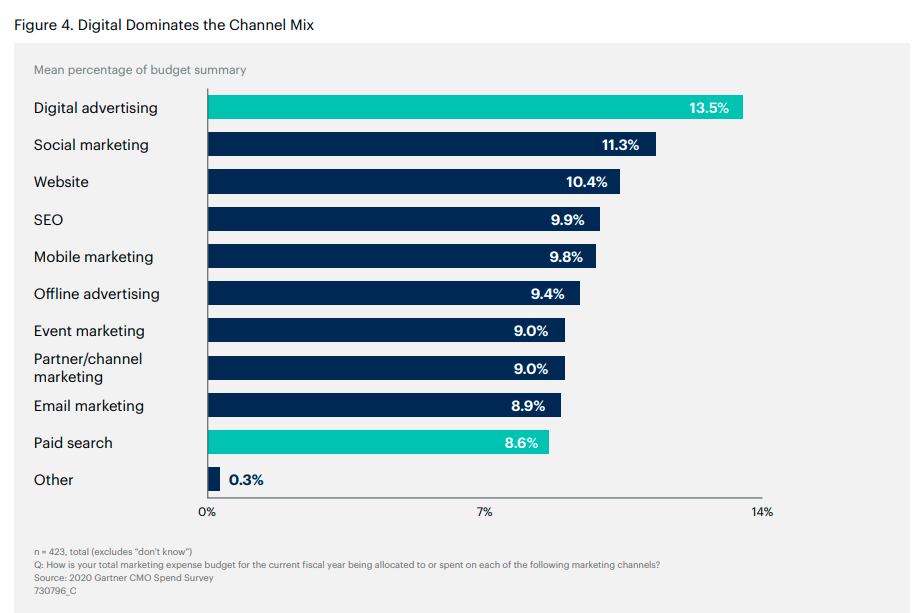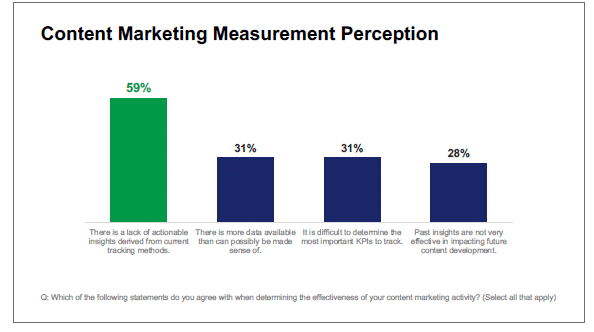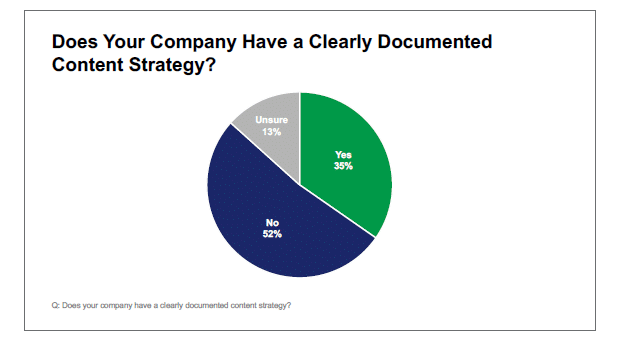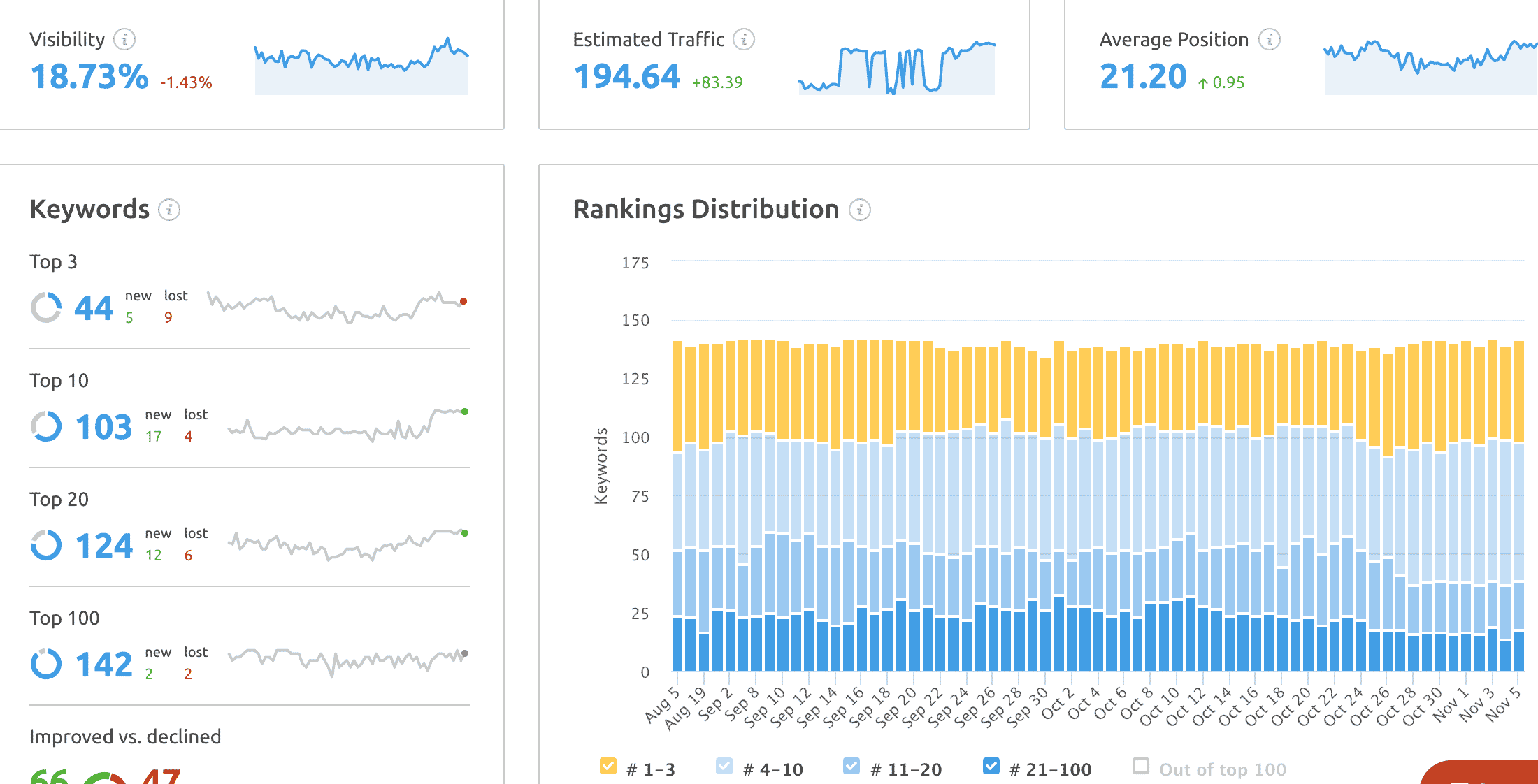
This Amount Is All The Marketing Budget You Need
Are you feeling pressure on your marketing budget? If you think you can’t stretch your dollars to meet all your marketing needs, you may actually need better allocation, not more money.
The objective of marketing is to attract, engage, convert, and retain customers. And we have found that most small to midsize organizations can do all that and more by focusing on content marketing. So what amount do you need.
In looking across our clients and some of most successful brands doing content marketing today, we have found that number is around $8,000 a month.
That’s right, for just $8,000 per month, you can get a content marketing strategy, a year’s worth of content ideas, an SEO audit and keyword strategy, external link building, conversion funnel development, and paid promotion to reach all the new people you need to grow your business.
What about results? On average, this investment delivers measurable returns in the form of 138% more inbound traffic to your website vs last year.
But we can’t take traffic to the CFO. We also help our clients deliver 7x in return for every dollar spent. That’s $56k in revenue for every month. But these results don’t come over night, These numbers are for content marketers who invest for at least a year. The average break even point in around 7 -8 months.
So let’s dive in and learn how you can get these results as well!
It’s never too early to start working on your company’s marketing plan for the upcoming year – just ask the accounting department. For B2B and B2C marketers alike, there are many conversations to be had about the impact your budget will have on your marketing capabilities and strategy.
Use this guide to assess your company’s current marketing practices and discover the marketing methods you may want to introduce in next year’s plan.
Know How Marketing Budgets Are Shifting
Marketing budgets had been steadily rising. A survey from Merkle of 400 companies revealed that the majority (52%) are increasing marketing spend. The priority of these dollars was:
- Adopting new marketing technology.
- Becoming more consumer-centric with messaging.
- Developing new capabilities to fulfill transactions.
But one of the areas tha has taken a huge hit is traditional ad spending. Paid advertising is somewhat of a dinosaur. There are, of course, many channels to use for traditional advertising, but its value, especially to B2B companies, is diminishing.
These developments are in alignment with how customer needs change and other disruptions.
With budgets being in flux and lots of uncertainty, reallocation of dollars is a necessary consideration.
It’s not really what you spend but how you spend it that matters in any budget. So, how are most organizations spending their dollars?
To look at where the money’s going, The CMO Spend Survey provides context.
Digital accounts for 80% of marketing channel budgets across paid, owned, and earned channels. Digital advertising has the most significant chunk of companies’ budgets, followed by social, website, SEO, and mobile marketing.

This survey doesn’t ask about content marketing spend, which could fall under the website and SEO categories. The ANA (Association of National Advertisers) recently released a report, Growth and Opportunities in Content Marketing. The data showed a 73% increase in content marketing spend in the past two years. It also projects a 42% further increase in the next two years.
Brands are showing a commitment to content marketing with substantial dollars, but are they really getting positive returns? Much of that has to do with if they are properly following the tenets of content marketing. The ANA report found that 59% of the respondents lack actionable insights with current content performance metrics.

Putting money into the right channel is only the beginning of maximizing your marketing dollars. If you aren’t engaging in the most important aspects of content marketing, which is to produce and publish relevant content consistently that ranks high, you can throw money at it all day and not see the results you desire.
Analyze and Benchmark Past Marketing Successes
Marketing is a balancing act and when you’re trying to increase qualified leads, it should never be a guessing game. To develop a truly successful marketing plan, you first have to look back at marketing plans from years past.
Use data from Google Analytics, your email marketing service and your marketing automation system to understand what sources are driving the most leads. Once you have tangible numbers, you can identify which sources contribute the highest percentage of total revenue via leads and conversions.
After you’ve collected year-over-year analytics data from each marketing channel and their corresponding sales metrics, you should ask yourself two simple but important questions:
- What’s working?
- What’s not working?
Unfortunately, each marketing tactic cannot be evaluated in the same way. While print ads offer circulation data, you can’t determine the exact number of readers who flipped through a publication’s pages. On the other hand, display advertising can provide definitive findings as to the size of the audience, the amount of impressions and click data.
Do your best to prioritize marketing tactics based on an unbiased review of their performance each year. When analyzing performance, try to maintain a holistic view of your business. What outside factors are influencing business development besides marketing? The loss of a key employee or the emergence of a new local competitor could be to blame.
Return on marketing investment (ROMI) can be tough to navigate, but with persistent research, you can optimize the channels that are working in your favor and pull back marketing spend on the tactics that aren’t.
Determine Your Marketing Goals
Once you’ve familiarized yourself with the success of your past and current tactical marketing plans, it’s time to determine your marketing goals for the year. After all, you can’t take a road trip if you don’t know where you’re headed.
Your marketing goals should be strategic objectives that are quantifiable and specific.
Define your goals on multiple levels; start from the top by determining your short and long-term business objectives. With this information, you can understand the amount of revenue you will need to achieve those goals and therefore the number of new leads you will need to generate. This is where the fun starts. Armed with these numbers and your data from step one, you can begin to break down these goals even further, setting success measurements for each marketing channel and tactic.
For tactical goals, be specific in terms of budget and results. How much are you willing to spend on this tactic? How many clicks or new leads do you expect this tactic to generate? Here’s an example:
- Channel: Digital marketing
- Platform: Google AdWords
- Tactic: PPC campaign
- Spend: $3,000/month
- Goal: 500 clicks, 30 conversions
It’s important to establish objectives, but there should be some element of flexibility. Many factors that will impact progress toward your goals are constantly in flux, such as the cost associated with certain keywords and ad groups on Google AdWords.
Keep in mind that circumstances may change throughout the year and budgets may have to be adjusted. If your current structure does not allow for budgetary changes, your goals and expectations should be altered accordingly.
Consider Every Digital Marketing Channel
There are multiple marketing channels to choose from when creating your 2018 plan, but most marketers will recommend an integrated approach. If your budget is tight, it may be in your best interest to focus investments on one or two channels. Here are a few channels that every modern marketer should consider:
- Display advertising & pay-per-click (PPC): Advertising via search engines and partner websites is becoming increasingly commonplace as technology advances. Display advertising is an economical online advertising method, offering the opportunity to display graphic banner ads on website categories of your choosing. PPC, while more costly, is extremely customizable; advertisers can specify bids, ad copy, display time of day, location targeting and more.
- Email marketing: A standard among most companies, there are still realms to explore in the world of email marketing. Experiment with email workflows to capture leads and incorporate responsive elements to heighten engagement metrics.
- Social media advertising: For marketers who have established a strong social media presence for their company, social media advertising is an excellent tactic to incorporate. LinkedIn is the most beneficial for B2B marketers, while Facebook, Instagram and TikTok suit B2C marketers.
- SEO: Optimizing your website for search engines is becoming increasingly important. How many times do you Google per day?
- Traditional marketing: Traditional marketing methods have been a staple in the industry for decades and most are still in use. Direct mail, event marketing, television spots and print advertising are just a few tactics that are still a core focus for many marketers.
Prioritize Your Needs
This is the hard part. Marketing on every platform is the ideal strategy, but for SMBs and startups, this may not be realistic.
To prioritize your marketing needs, start with the most costly endeavors. Choose the tactic that is the most effective at driving leads and go from there.
Once you’ve incorporated the tactics that require the most spend, you can balance the rest of your budget with more cost-effective tactics.
Most B2B and B2C marketers find that working with an agency is helpful in determining the best marketing mix. For most of our clients, the marketing channel priorities that garner the most online success include:
- PPC campaigns
- Content marketing
- SEO
Ultimately, there’s no magic formula. Your marketing budget should be a mix of different methods, based on the resources you’re working with and the audience you’re trying to reach.
Optimize Your Content Marketing Strategy
Content marketing is not an option in the B2B space, because industry content may not be as readily available to interested consumers. This content not only serves as quality editorial copy on-site, but it also has the potential to be leveraged for lead nurturing and demand generation purposes.
Let me now walk you through how to spend your $8,000-per-month content marketing budget.
The first step to only spending $8,000 a month on marketing is having a content marketing strategy. Most organizations don’t have this—the ANA study discovered 52% of organizations responding did not.

Without a content marketing strategy, it’s impossible to follow the tenets of the discipline and expect to drive traffic and convert leads.
We work with our clients to build one from scratch or optimize their current one. A comprehensive content marketing strategy includes:
- Content mission, purpose, and goals.
- Content pillars: The category topics you’ll write about.
- Content types: Blogs, long-form, social, etc.
- Brand voice and tone: Attributes of your brand’s voice, foundational language, and other elements that impact the words chosen.
- Content output: How much content you’ll produce on a monthly basis.
- Buyer personas: Fictional representations of who your buyers are that help you understand their needs and motivations.
- Roles and responsibilities of content creators: Writers, editors, designers, etc.
- Distribution methods: Social media, third party sites, email marketing, etc.
Another important aspect of your strategy is keywords and SEO best practices, but that deserves its own section.
Perform Keyword Research and SEO Audit
One of the first things we do with new clients is an SEO audit to understand what, if any, keywords you currently rank for on Google. Keywords still matter in effective marketing.
Additionally, such an evaluation looks at the mechanics of SEO behind the content, such as URL formatting, meta descriptions and titles, and alt tags. The last part of the audit is off-site assessments to see if any backlinks exist and their quality.
Once we have a baseline for keyword ranking, it’s time to conduct keyword research. Keyword research is just another name for audience discovery on search engines. Keywords have considerable value for your content marketing efforts. You may just be looking at them from a slightly distorted angle.
When you begin a strategic keyword search, you’re really learning about your audience and what and how they search.
We start with seed keywords that are relevant to your industry, solutions, and themes. The data from this includes:
- Volume: How often users input that keyword when searching.
- Competition for the keyword organically and paid.
- The average cost-per-click for that keyword.
That’s only the beginning. Most seed words are very general, and if you can get more specific, you’ll be more relevant to your buyers and possibly face less competition.
Using a tool like Semrush, we take a seed word then expand to find complete phrases or questions searchers are typing into Google. We also use tactics like looking at Google autocompletes for the phrase and related searches.
We start to develop a keyword master list with targets, but you also need to understand who your competition is for that keyword. SEO competitors aren’t always direct competitors. For us, HubSpot sort of competes with us on content, but not in any way in the real market of products or services. We don’t sell CRM so we partner with them on content.
Understanding competition is not about copying what you know is ranking well. It’s about analyzing why it’s ranking well—then developing a piece of content that’s better. The “better” means optimized with keywords but not stuffed, high readability scores, internal linking, and ensuring all the details around metadata, alt texts, slugs, and more are accurate.
The keyword research we provide our clients is detailed and ongoing. Each month, they receive a search visibility report charting the improvements in ranking. SEO is a long-term, integral part of content marketing. You’re never really “done” with it. Everything can change in an instant. Simply consider how the pandemic changed online searches in basically every vertical.
List Out Your Content Ideas
The next part of your $8,000 a month program is content ideas. It brings together the first two parts of the plan—your content strategy and keyword research.
The output for our clients is two articles per week, one long-form article, and one landing page per month. That’s roughly nine pieces a month. Coming up with ideas isn’t necessarily hard if you have the research and foundation in place. However, it’s not just the actual topics to ponder. You also need to ensure you have the right mix of content for each buyer persona and each stage of the sales funnel.
We provide our clients with a year’s worth of content ideas. How do we do this?
The content strategy has a lot to do with content ideas. From this, we know the content pillars most important to your company and customers. We’ve defined your buyers and what challenges they face.
Content ideas can change as we collect more data about what your buyers find interesting. This data is imperative to maintaining relevancy to your audience.
Finally, we develop a blog editorial calendar, via which we make sure you have content for top-of-the-funnel, middle-of-the-funnel, and bottom-of-the-funnel. It’s critical to have a balance to engage buyers at every phase, attracting, nurturing, and closing.
On your calendar, we place content based on your goals, promotions, and prioritizes. If you’re rolling out a new feature to your software in the next 90 days, you’ll likely want to produce several pieces of content about it and the problems it solves. Seasonality can also impact what you schedule. Businesses that sell to secondary or higher ed work their content around school years and understand when these customers are most likely to buy.
Promote Your Content on Paid & Free Channels
Content marketing will produce results. You’ll see most of these results through slow growth in organic search traffic. And while this is the goal, it also helps to prime the market with paid promotion. This helps us to nearly guarantee results.
We do this with contextual ads, using a native AI-driven placement platform. Our paid content promotion gets 80% lower PCP and nearly 6x the CTR of the average company’s paid promotion!
We are able to accomplish this because we only promote your best content, to a relevant audience, on contextual platforms. And our AI-engine optimizes the spend so we are always reaching the right people in a more efficient way.
Your content is matched with other relevant digital content via algorithms that look at keywords and other metadata. It works to create an integrated solution that doesn’t require hours of manual work.
With multiple channels, campaign automation, and tracking, it’s an excellent choice to disperse content in a very targeted and strategic way.
Watch Your Analytics
With all these initiatives, you certainly want to know your return on investment (ROI). As you’ll recall, content marketing ROI is elusive to many organizations. It’s hard to connect the dots and discern what content led to meeting goals. Further, many brands don’t necessarily define what ROI means to them. There are three key metrics that essential to content marketing ROI:
- Conversions: How content directs users to convert, whatever the definition of conversion may be.
- Percentage of closed leads: Every lead has a source; if content is what brought that buyer to the table, then it’s responsible, at least partly, for the win.
- Percentage of sales: Some customers close without ever talking to sales. It’s happening more and more for B2B companies, especially those with millennial decision-makers. Look at the percentage of your sales that you can directly contribute to content marketing.
So we start by identifying how much traffic and visibility we are bringing to your website.

Then we analyze your conversion paths and make sure we have enough offers, subscriber landing pages and calls to action. We even will setup goals for you in google analytics to track all these.
Then we automate reporting from GA and your CRM tool to show actual conversions, leads, and sales.
Each month, we provide our clients with the SEO visibility report, as well as Google Analytics goal reporting. Goal reporting is an essential metric for content performance.
You can clearly identify users who’ve completed your goal. The goal could be they go from a blog to a landing page with a demo call to action. It could be that someone provided their contact information to download a gated eBook.
You’ll also be able to see how much traffic your content is pushing to your site and from where—organic results, paid, social, etc.
Does Your Budget Align with Your Goals?
Our guess is that you spend more than $8,000 on marketing every month. Is that working for you? Are you ranking high and driving traffic? Are your conversions on the rise with the power of content?
If not, then your budget may not be in alignment with your goals. Let’s get them on the same page.
If you’re ready to get more traffic to your site with quality content published consistently, check out our Content Builder Service.
Set up a quick consultation, and I’ll send you a free PDF version of my books. Get started today–and generate more traffic and leads for your business.






